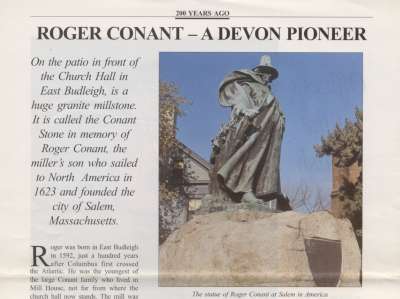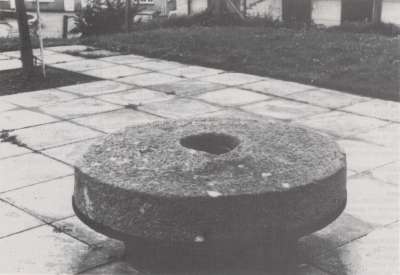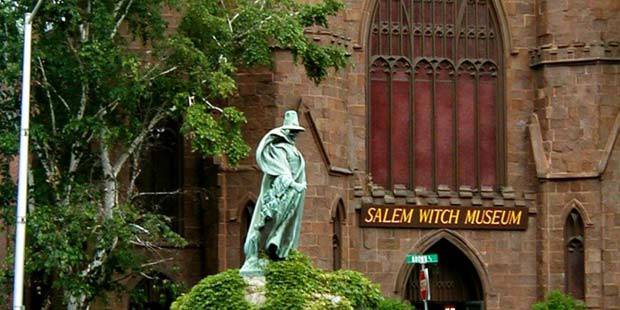
In 2010 Solomon Green contacted Edward Conant and passed a book and some documents that his cousin Lisbeth Conant had owned until her recent death. Included amongst these was the article below. Lisbeth Conants husband Peter Conant was very proud of his family and Solomon Green thought the documents would be best kept in the Lyndon Hall library.
With thanks to the Devon magazine which printed the article in the 1990's and to Vivien Brenan, who wrote the text and to John Proctor who took the photographs.
Roger Conant - A Devon Pioneer
On the patio in front of the Church Hall in East Budleigh, is a huge granite millstone. It is called the Conant Stone in memory of Roger Conant, the miller's son who sailed to North America in 1623 and founded the city of Salem, Massachusetts.

Roger was born in East Budleigh in 1592, just a 100 years after Columbus first crossed the Atlantic. He was the youngest of the large Conant family who lived in Mill House, not far from where the church hall now stands. The mill| was fed by the Budleigh Brook which winds through the village. Nearby is an ancient house, once the vicarage but now a private house called Vicar's Mead. Up the hill keeping watch over the village is the medieval church of All Saints, William Conant, Roger's father, was a churchwarden as well as being the miller and so an important person in the community: One of the carved oak pew ends in the church bears the Conant Arms. Roger and his brothers probably received their early education from the Vicar and would have become familiar with the book of common prayer, established by Queen Elizabeth I's Act of Supremacy in 1559 as the only legal form of worship in England.
If the Church of England was one of the abiding influences in Rogers' life, the other was the sea. East Budleigh lies in the valley of the River Otter, two miles from the coast at 'Salterne' (now Budleigh Salterton), where fishing boats put out from the pebble beach. From the fishermen and from sailors returning from longer voyages, Roger would have heard many a tale of the exploits of Devon seamen - Drake, Hawkins and above all Raleigh. Raleigh was born in 1552 at Hayes Barton Manor, a mile from the village. Roger may have read Raleigh' s ''Voyage to the Demerary'' and also a book called ''A Discovery of the Bermudas. Other wise called the Isle of the Devils''. This was written in 1610 by Silvester Jourdain, whose brother Ignatius was an Exeter magistrate and merchant and friend of William Conant.
When they were old enough, Roger and his brother Christopher were sent to London to learn a trade. Roger was apprenticed as a salter and in 1616 he became a freeman of the Salters' Company. In Devon with its many fishermen, a qualified salter would be sure of good living. However Roger had other ideas. In London he heard much about the growing dislike of the Puritans. Some Puritans simply wished to keep the church free from Catholic ceremonial tendencies: This was the way Roger had been brought up in East Budleigh and it was the feeling of most West Countrymen.
However in London and East Anglia, there were many ''separatists'' who wanted to leave the established church and worship in their own way. It was such men who in 1620 sailed to North America in the Mayflower and founded the first settlement in Massachusetts, naming it Plymouth after the Devon port from which they had set out.
Roger and Christopher were much interested in the reports that came back to London about the progress of the little colony, so much so that in 1623 first Christopher and then Roger with his wife Sarah, emigrated to America. They were well received in new Plymouth; Roger as a salter was especially welcome. However he soon found that he was not in sympathy with the extreme separatist religious views of the Pilgrim Fathers. He was glad therefore when the opportunity came to move away from Plymouth. Back home in England a group of West Country merchants had recently formed the Dorchester Company to encourage development in Massachusetts. In 1625 they sent a number of emigrants, including a Church of England minister called Lyford to Cape St. Arm, North of Plymouth, with the intention of forming a new settlement independent of the Pilgrim Fathers.
Roger Conant joined them and was chosen as their leader. Under his direction they set up a fish curing station and tried to farm. Many ships brought their catch to St. Ann and the salting side of the venture did very well. However the exposed headland was a poor place for agriculture and bitterly cold in winter. Many of the would-be settlers gave up and went home to England, but Conant and some 40 or 50 determined pioneers stayed and moved to a more sheltered and fertile area called Nahum Keike. Living was better there. The Dorchester Company supported themselves by sending supplies, including 20 cattle, to help establish agriculture and so make the settlement self-sufficient. In time, successful farms developed; Conant and four of his followers each had 200 acres of land. Another eight had smaller properties. they continued to maintain the fish curing station during the summer months.
During all this time of hardship, the little group of settlers looked to their leader Conant for guidance and encouragement. Even when his friend the minister Lyford, urged him to move south with him to the easier land of Virginia, Roger refused to go. More difficulties arose when the Dorchester Company having failed. a new company was formed called the ''New England Company for a plantation in Massachusetts Bay''. They appointed a Governor named John Endicott, also a Devon man. His grandfather was a wealthy Chagford tinner. He arrived in 1628 accompanied by more settlers including two fiercely separatist ministers named Higginson and Skelton. Roger Conant, helpful as always, handed over to Endicott without protest and endeavored to get on with the new Governor.
This was not easy; Endicott was an able man but harsh and intolerant First there was a difficulty over the name of the settlement. Nahum Keike was not thought suitable for a Christian English community. Conant wanted the name of his home village. Budleigh, but Endicott and his friends the ministers decided on Salem. Roger accepted the decision with grace but he was deeply disturbed when, urged on by Higginson and Skelton, the governor forbad the use of the Book of Common Prayer. There was protest from the earliest settlers who had come with Conant. Two brothers, John and Samuel Broad, refused to comply and were expelled from Massachusetts and went angrily back to England.
Conant himself avoided an outright clash with Endicott but he ceased to take part in public affairs. He lived quietly but was always ready to help and advise new settlers. He died in 1678 at the fine age of 86. Today in Salem there is a statue of its founder Roger Conant. His descendants keep in touch with East Budleigh and their names can be found in the church visitors book.
With thanks to Elizabeth Joyce Joseph of Willits, California, from whose web page the following was taken in March 2015:
Roger Conant was born in East Budleigh, Devonshire, England in 1592, the youngest of eight children.
In 1623 he emigrated to Plymouth with his wife, Sarah and son, Caleb.However, he was uncomfortable with the strict Pilgrim society in Plymouth and moved his family to Nantasket in 1624.
In the late autumn of 1625, Conant was invited by the Rev. John White and othermembers of the Dorchester Company to move to their fishing settlement on Cape Ann as theirgovernor. Still looking for more favorable conditions for a settlement, he led a group of people to Naumkeag, now Salem, in 1626, and continued as their governor.
In 1627 a patent was solicited from England and it was obtained by a group led by John Endicott who arrived in Naumkeag in 1628. Endicott and the other settlers of the New England Company now owned the rights to Naumkeag. Fortunately for the peaceful continuity of the settlement, Conant remained in Salem and, despite what must have been a disappointment for him, acceded to Endicott's authority as the new governor.
Conant built the first Salem house on what is Essex Street today, almost opposite the Town Market. In 1639, his was one of the signatures on the building contract for enlarging the meeting house in Town House Square for the First Church in Salem.
This document remains part of the town records at City Hall. He was active in the affairs of the town throughout his life. In 1679, he died at the age of 87.
This dramatic, cloaked statue of Roger Conant faces the Salem Common and stands atop a huge boulder brought from the woods near the floating bridge at Lynn.Artist Henry H. Kitson designed this heroic bronze statue for the Conant Family Association and the statue was dedicated on June 17, 1913.
Roger Conant and Salem
A handsome statue of Roger Conant, the founder of Salem, stands outside the Salem Witch Museum. Because of the statue's proximity to the museum and because of his cloak and hat and generally impressive appearance, Roger Conant is often mistaken for a participant in the Salem witch trials. Nothing could be farther from the truth.

We know that Roger Conant was baptized in All Saints Church in the parish of East Budleigh, Devonshire, England on April 9, 1592. His father was the leading merchant of Clayton, a neighboring parish. Family tradition says that as a boy young Roger met Sir Walter Raleigh. Later Conant and his young family came to New England probably arriving in Plymouth in 1622.
The Dorchester Company established a fishing settlement on Cape Anne during the winter of 1623-24 under a charter with England. Located at Stage Point, now Gloucester, the company invited Roger Conant to join them in 1625 as their governor, "for the management and government of all their affairs at Cape Ann". After a year's residence, Conant became convinced of the need for a more permanent settlement and found an ideal site at the mouth of the Naumkeag River (now the City of Salem).
There the settlement thrived and grew by farming as well as fishing. When Governor Endicott arrived in 1628, he incorporated Conant and his men into the new government. (The Dorchester Company went into bankruptcy in 1627 and became the Massachusetts Bay Colony in 1629 under charter from England). Known as the Old Planters, Conant and his followers lent continuity to the new settlement and can be considered the founding fathers of Naumkeag, renamed Salem for "Shalom" or Peace on June 29, 1629.
Roger Conant died on November 19, 1679 considering himself "...an instrument, though a weak one, of foundering and furthering this colony..." After Conant's death, the colony suffered through the witch trials of 1692.
As the world grew smaller in the 18th-century, Salem took a leading role in developing international trade routes and enjoyed a period of prosperity and fame. The 19th-century saw the advent of immigrants who enriched the business and cultural life of the city as shipping was replaced by rail transportation. Born in Salem on July 4, 1805, Nathaniel Hawthorne took inspiration from his native streets. By the 20th-century Salem had grown from a colony struggling with crisis to a cosmopolitan city. Today Salem is a city of fascinating complexity. Traces of her history can be seen everywhere from the 17th-century buildings, the priceless items brought back from exotic ports by Salem ship captains, the extraordinary architecture and the multi-ethnic character of her streets. The city of Salem attracts visitors today as the harbor and rivers and fields of Naumkeag drew Roger Conant over 300 years ago.